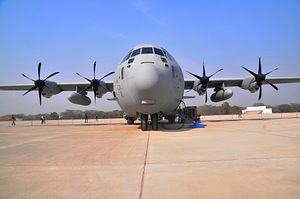As I wrote earlier for The Diplomat, reports had surfaced on Sunday that a Malaysian military transport plane was intercepted by two Indonesian jet fighters over Indonesia’s Natuna Islands on Saturday (See: “Indonesia Fighter Jets Intercept Malaysia Military Plane Over Natunas“).
Local media had indicated that a Royal Malaysian Air Force (RMAF) C-130 had been intercepted by two Tentera Nasional Indonesia – Angkatan Udara (TNI-AU) F-16 jets.
According to the Malaysian daily The Star, Malaysian defense minister Hishammuddin Hussein had initially confirmed that the aircraft was intercepted by the jets. But it also cited a source as saying that the Indonesian jets were only notifying the aircraft that it had entered Indonesia’s airspace rather than intercepting it. RMAF chief General Roslan Saad was more cautious, saying that Malaysia was investigating the incident and he was not able to provide any input.
In a statement released Monday by the Malaysian defense minister Hishammuddin Hussein and seen by The Diplomat, the Malaysian government denied that any intercept had occurred. According to this account, which Hishammuddin said was based on a full briefing he had received from Roslan, the C-130 departed from Subang Air Force base at 10:10 a.m. on Saturday for a scheduled training mission with a predetermined flight plan towards Labuan Air Force Base. At 12:03 p.m., it received a visual identification from a TNI-AU F-16, 24 miles from the Natuna Islands at a height of 23,000 feet, with the other F-16 behind the C-130 as well.
But according to the statement, all attempts by the C-130 to contact both F-16s “failed to receive a response,” and both aircraft then “dispersed from the airspace without any further incidents.”
“It must be noted that MEGA 207 was not intercepted by TNI-AU,” the statement noted, referring to the call sign of the C-130 aircraft. “An interception warrants the forcing down of our RMAF C-130 which did not occur. It was a mere visual identification of our aircraft,” it added.
Hishammuddin went on to emphasize that the C-130 was conducting a scheduled training mission on a pre-determined flight route, in accordance with a flight plan that was sent using the usual standard operating procedure. He also stressed that this was in line with an existing February 1982 treaty between Malaysia and Indonesia, which related to Malaysia’s rights in the territorial sea and archipelagic waters as well as in the airspace above the territorial sea, archipelagic waters, and territory of the Republic of Indonesia lying between East and West Malaysia. Under that treaty, he said Malaysia had the right to “conduct aerial maneuvers, including tactical exercises, through the airspace above the territorial sea, archipelagic waters and the territory of the Republic of Indonesia.”
Given this, he said Malaysia “will continue to use this route without any reservations,” and that he had directed the RMAF chief to “take whatever action is needed to operationalize our rights on using this route.” He also said he would bring up the issue directly with his Indonesian counterpart Ryamizard Ryacudu when he meets him next month in Jakarta.
On the Indonesian side, TNI-AU spokesman Air Marshal Wiko Sofyan had told reporters Sunday that the C-130 had been flying in Indonesian airspace on Saturday and that after Indonesian jets tried to communicate, they “did not get a response” from the Malaysian plane. That conflicts with the Malaysian account of events.

































